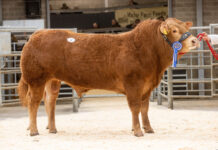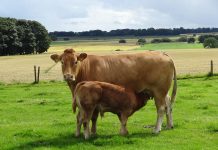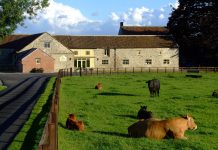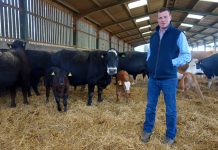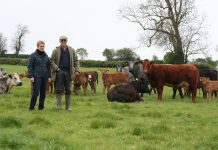
Northumberland-based store cattle producer, Roland Telford has tried several terminal sire breeds for producing store animals for the auction market, but he feels that a switch to using the Limousin exclusively five years ago was the right decision. He has no intention of changing policy again.
Roly and his wife, Kathleen, farm a total of 3,000 acres of land from their base at Branton East Side, a mixed holding at Powburn, near Alnwick. Some 850 acres are owned by the family, with the rest rented from various landlords in the area, including a 1,300 acre hill farm close by.
A sizeable parcel of land is classified as falling within an LFA (Less Favoured Area), and rises up as high as 1,800 feet above sea-level. Therefore, the cattle are required to be hardy. The hill farm can support 70 cattle over the summer, and 50 are kept there over the winter.
Until two years ago, the business included 400 breeding cows. However numbers have been scaled back to 350, partly because of the rising cost of straw bedding. The farm runs a total of nine Limousin stock bulls, also buying in mainly Limousin cross heifers as replacements, although Simmental and Belgian Blues also feature in the herd. Both the Blonde d’Aquitaine and the Charolais have been used as sires in the past.
Roly looks for bulls with size and length – the “stretchier” type, as he describes them. As with all cattle breeders, he considers that good legs and feet are two of the most important traits. He feels there is no point in paying too large a sum for a bull which goes out on the hill with the cows for several months at a time.
Good bull EBVs are relevant when choosing a new animal, says Roly. He ranks ease of calving as the most important trait. This practice has paid off, because only one caesarian was performed over the whole autum-calving group, he says.
The bull team at Branton East Side includes three animals from Andrew Proctor’s Swarland herd near Alnwick. Swarland Charlie, by Samy, Swarland Cheekyboy, by Limo Tanat, and Swarland Exterminator, by Hartsideanew Boumsong and out of Swarland Bluebell.
The rest of the group includes a Tomschoice bull by Sarkley Topknot and Tweeddale Commando, by Sarkley Pepsi. There is also Burndale Austin, by Sympa, Rombalds Alfie, by Oxygene, and an Elmtree bull. All the sires were purchased at Carlisle and insured for their first year.
“I am very careful to protect my herd health status,” says Roly. “That is why I only buy in young bulls and bulling heifers. The cattle are four-year tested for TB, as well as being vaccinated against BVD and Leptospirosis. They are quarantined and blood-tested as soon as they arrive. I like to buy cattle from four year TB-tested herds.
“Johne’s is another disease I am anxious to avoid, and it is linked to another positive attribute of the Limousin – a high percentage of herds are Johne’s-free,” he says.
When searching for replacements, Roly looks for well grown heifers with wide hips and plenty of milking potential. Durability is essential, and he avoids extreme Holstein characteristics when buying Limousin cross Friesians from the dairy herd.
The herd is split into two groups, with 200 calving in the spring, and the remainder during the autumn. Roly would like to block calve both groups over a period of nine weeks, but current figures stand at an average of 12 weeks.
“I have been adding heifers at a greater rate recently, because the cull cow price has been so good. I sold 14 culls at St Boswells Mart recently and they averaged 140ppkg, a price I was very pleased with. At one point, cull cows were making £900 plus, with bulling heifers at £1,000 plus, figures which I view as a reasonable turnaround.
“Animals that are not in calf will be moved into the other batch if they are young, but older cows or those with faults do not get a second chance. But that doesn’t mean I will sell a cow if she is still producing a calf, whatever her age. Nevertheless, the average age is around six to seven years. If I have cull cows to go over winter, I will get them in good condition, by feeding them a total mixed ration.”
The farm has its own mill and the TMR fed through the winter months is based on silage and home-grown rolled barley. Wheat may also be added to the ration, along with protein, usually in pellet form, although DDGs are sometimes used. Stores receive a diet based on home-grown rolled barley.
Autumn calvers calve outdoors, with calves offered a home-made concentrate mix at housing in November. They also receive hay. Spring calving cows are brought inside, with the cow and her calf turned out within three weeks of the birth. At housing, calves are left on their dams until the first week in January, to reduce growth checks and pneumonia caused by stress. Spring calves eat the TMR alongside their mothers prior to weaning.
The original cubicles have been taken out of a cattle shed, partly because the animals were getting too big to fit in comfortably. Although large quantities of straw are produced, there is still a cost attached, and Roly estimates that he had to spend an additional £8,000 on supplementing his own supply over the 2010/2011 housing period. He has always planned for a 200-day winter, but it has lasted much longer over the past two years, he says.
Autumn-born animals leave the farm at 11-13 months, while spring-born calves are taken to 10-12 months old. All the stores are weighed pre-sale and go through the ring at Wooler, where they find a ready market.
“We used to finish cattle when we owned land near the coast, but we gave that up when the opportunity arose to buy additional land close to home,” says Roly.
“I have been tempted to return to finishing, but we have other enterprises and it is much simpler to sell stores.
“If I were farming on a smaller scale, then things might be different, but I have a lot of livestock and the buildings already come under pressure at housing. Another reason for our present policy is that I feel the different elements of farming are becoming more specialised, and finishing cattle requires careful attention, if sufficient returns are to be achieved.”
The farm also grows a range of cereal crops and supports a 2,400-strong ewe flock. With such a large acreage to look after, the farm has several staff, including three full-time shepherds, and three men who mainly work with the cattle and on the arable land. Roly stresses that capable staff are an invaluable asset.
The herd has enjoyed some success in the competitive field. In 2009, Branton East Side Farm was announced as the winner of the first ever Glendale Agricultural Society Herd Competition, also receiving the prize for best individual animal. The judge was Robert Neill of Upper Nisbet Farm, Jedburgh who was charged with finding the herd with the best individual breed characteristics and the best management system.
Roly does not need to say much about his views on theLimousin. They are borne out by his decision to stay with the breed, which he believes offers farmers the best opportunity of maintaining profitability.
“Limousins also offer the widest selection of bulls, and a great deal of genetic progress has been made on performance over the years. We plan to stick with them into the forseeable future.”









